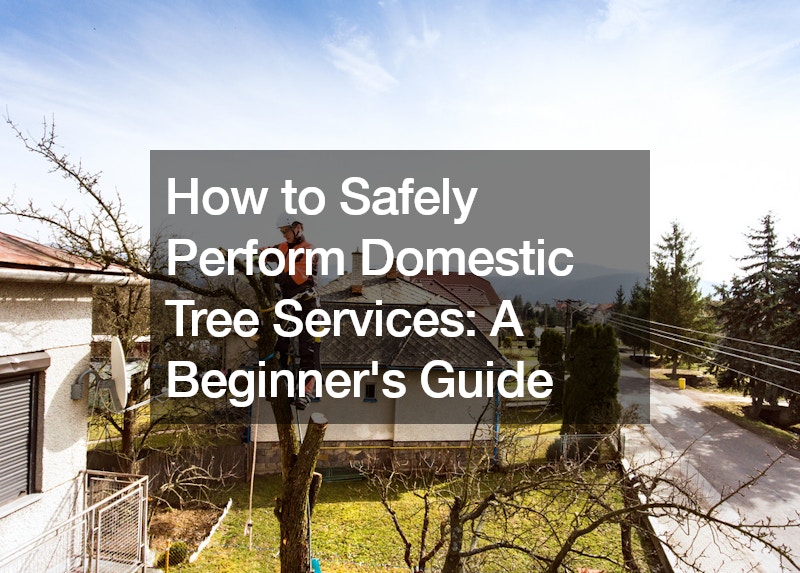Maintaining trees on your property is not only essential for enhancing curb appeal but also crucial for safety and the overall health of the environment. However, performing domestic tree services requires proper knowledge, tools, and safety measures to ensure success. In this beginner’s guide, we’ll explore key steps and tips for safely conducting domestic tree services.
Understanding Domestic Tree Services
Domestic tree services encompass a range of activities aimed at caring for trees within residential properties. These services include tree pruning, trimming, removal, planting, and disease management. Proper execution of these tasks not only enhances the aesthetics of your landscape but also promotes tree health and longevity.
1. Assessing Tree Health and Safety
Before embarking on any tree service, it’s crucial to assess the health and safety of the trees on your property. Look for signs of disease, decay, pest infestations, and structural weaknesses such as cracked branches or leaning trunks. Identifying potential hazards helps prioritize necessary actions and ensures the safety of both the tree worker and the surrounding environment.
2. Tree Pruning and Trimming
Pruning and trimming are essential maintenance practices for promoting tree health and aesthetics. Remove dead, diseased, or damaged branches to improve air circulation and sunlight penetration. Additionally, proper pruning techniques help maintain the tree’s natural shape and prevent overgrowth, reducing the risk of limb failure during storms.
When pruning, remember to:
Use sharp, clean pruning tools to make clean cuts.
Avoid removing more than 25% of the tree’s canopy in a single pruning session.
Cut just outside the branch collar to promote proper healing.
3. Tree Removal
In some cases, tree removal may be necessary due to safety concerns, disease, or declining health. However, tree removal should only be undertaken as a last resort and preferably by trained professionals. Improper tree removal can result in property damage, injury, or even death.
4. Planting and Transplanting
Planting new trees or transplanting existing ones requires careful consideration of factors such as soil conditions, sunlight exposure, and spacing. Choose native species suited to your climate and soil type to ensure long-term viability. Proper planting techniques, including digging an appropriately sized planting hole and providing adequate water and mulch, are essential for successful establishment.
5. Disease Management and Pest Control
Effective disease management and pest control are vital for preserving tree health and preventing widespread infestations. Regularly inspect trees for signs of disease or pest damage, such as unusual leaf discoloration, wilting, or bark abnormalities. Consult with arborists or extension services to identify and treat specific tree ailments using environmentally friendly methods.Beyond the fundamental tasks of pruning, trimming, removal, planting, and disease management, several specialized services fall under domestic tree care. These services address specific needs and challenges associated with tree maintenance in residential settings.
1. Tree Preservation
Preserving mature trees adds value to your property and contributes to environmental conservation. Arborists can assess the health and structural integrity of older trees and recommend preservation strategies. Techniques such as crown reduction, cabling, and bracing help mitigate risks associated with aging trees while prolonging their lifespan.
2. Emergency Tree Services
During severe weather events or unexpected emergencies such as fallen trees or storm damage, prompt action is crucial to ensure safety and minimize property damage. Emergency tree services provide rapid response and assistance, including tree removal, debris cleanup, and emergency tree stabilization to prevent further harm.
3. Tree Risk Assessment
Assessing the risk trees pose on your property is essential for proactive hazard management. Arborists conduct comprehensive tree risk assessments to identify potential threats such as structural weaknesses, root damage, or proximity to structures. Based on the assessment findings, recommendations are made to mitigate risks and enhance safety.
4. Soil Management
Healthy soil is vital for the optimal growth and vitality of trees. Soil management services focus on improving soil quality through techniques such as aeration, mulching, and soil amendment. These practices promote nutrient uptake, root development, and overall tree health, contributing to a thriving landscape ecosystem.
5. Tree Consulting and Planning
Professional tree consulting services offer expert advice and guidance on all aspects of tree care and management. Arborists collaborate with homeowners to develop comprehensive tree care plans tailored to their specific needs and objectives. From tree selection and placement to long-term maintenance strategies, consulting services ensure informed decision-making and sustainable tree management practices.
6. Urban Forestry Management
Managing trees in urban environments presents unique challenges due to limited space, soil compaction, and environmental stressors. Urban forestry services focus on maximizing the benefits of trees in urban areas while addressing urbanization-related issues. These services encompass tree inventory and mapping, tree preservation ordinances, and community tree planting initiatives to enhance urban green spaces and biodiversity.
Conclusion
Domestic tree care services extend beyond basic maintenance tasks, encompassing a wide range of specialized services tailored to the unique needs of residential properties. By leveraging professional expertise and implementing comprehensive tree care strategies, homeowners can ensure the health, safety, and beauty of their trees for generations to come.
.

